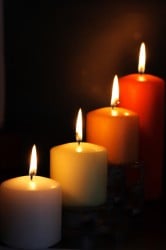After you’ve decided on a funeral home and are ready to begin the process of planning a funeral, your funeral director will ask you to come into the facilities for a visit. This personal contact with the people in charge of your loved one’s remains is an important step in the grieving process. Not only will you get to benefit from face-to-face interaction, but you’ll also be walked through each decision ahead of you. (more…)
What is a Perpetual Care Cemetery?
February 4th, 2016When you search for a cemetery as a final resting ground for you and your family, you are likely to come across the phrase “perpetual care,” “permanent care,” or “endowed care.” Often included as a charge above and beyond the typical cemetery costs, these are included as a way to ensure that the cemetery grounds remain in good care for decades (or even centuries) to come. (more…)
Different Types of Cemeteries
February 3rd, 2016Most of us assume that all cemeteries are virtually the same—after all, a piece of land where a body is laid to rest is a piece of land where a body is laid to rest, right?
While it’s true that most cemeteries perform the same general purpose to society, they tend to take different approaches to how this is accomplished. Some are religious, some are secular, some are run by the government, and some are closed to all but families with previously purchased burial plots. Depending on what type of cemetery you’re looking at, you could encounter any of the following types. (more…)
When is the Best Time to Scatter Ashes?
January 28th, 2016 One of the primary benefits of cremation is that you don’t have to hold a memorial service right away. With cremated remains, you can take days, weeks, months, or even years to get everyone together to hold a scattering ceremony. This kind of flexibility is important in our modern society, when families are spread out over the globe and can’t always rearrange their plans to travel to a funeral. (more…)
One of the primary benefits of cremation is that you don’t have to hold a memorial service right away. With cremated remains, you can take days, weeks, months, or even years to get everyone together to hold a scattering ceremony. This kind of flexibility is important in our modern society, when families are spread out over the globe and can’t always rearrange their plans to travel to a funeral. (more…)
How to Set a Funeral Budget
January 27th, 2016 Before you sit down with a funeral director to go over all your options for a loved one’s funeral plans, it’s a good idea to figure out how much money you’re willing to spend. Although the average funeral can go as high as $10,000, you aren’t required to spend this much—nor will you have to. With the right planning, you should be able to find a budget you’re comfortable with and buy a respectful, beautiful service to go with it. (more…)
Before you sit down with a funeral director to go over all your options for a loved one’s funeral plans, it’s a good idea to figure out how much money you’re willing to spend. Although the average funeral can go as high as $10,000, you aren’t required to spend this much—nor will you have to. With the right planning, you should be able to find a budget you’re comfortable with and buy a respectful, beautiful service to go with it. (more…)
What to Do the Day After a Funeral
January 25th, 2016 So much of planning a funeral has to do with the making burial preparations, reaching out to friends and family members, and finding ways to cope with your recent loss. And like many major life events and holidays, there is a kind of anticipation that goes into this planning process. Even though you may be feeling completely brokenhearted right now, the need to make decisions and put affairs in order provide a kind of foundation for getting through each day. (more…)
So much of planning a funeral has to do with the making burial preparations, reaching out to friends and family members, and finding ways to cope with your recent loss. And like many major life events and holidays, there is a kind of anticipation that goes into this planning process. Even though you may be feeling completely brokenhearted right now, the need to make decisions and put affairs in order provide a kind of foundation for getting through each day. (more…)
How to Get a Burial Flag
January 22nd, 2016 When planning a funeral for a United States veteran, you may be eligible to receive a U.S. flag to be draped over the casket or to accompany the urn. This service is provided free of charge and with a great respect for the service provided by the deceased.
Although burial flags are most often offered when an individual is having a traditional military funeral or burial, this doesn’t have to be the case. You may be able to receive a flag even if you don’t hold a service at all. (more…)
When planning a funeral for a United States veteran, you may be eligible to receive a U.S. flag to be draped over the casket or to accompany the urn. This service is provided free of charge and with a great respect for the service provided by the deceased.
Although burial flags are most often offered when an individual is having a traditional military funeral or burial, this doesn’t have to be the case. You may be able to receive a flag even if you don’t hold a service at all. (more…) Funeral Attire Dos and Don’ts
January 21st, 2016 Knowing what to wear to a funeral can be an added stress when you’re already grieving the loss of a loved one—especially if you don’t have the time or money to shop for a new outfit. For a quick and easy look at funeral attire tips, we’ve outlined some of the biggest dos and don’ts. (more…)
Knowing what to wear to a funeral can be an added stress when you’re already grieving the loss of a loved one—especially if you don’t have the time or money to shop for a new outfit. For a quick and easy look at funeral attire tips, we’ve outlined some of the biggest dos and don’ts. (more…) How to Create a Memorial Space in Your Home
January 11th, 2016 A funeral or memorial service is just the start of your bereavement process. Losing a loved one isn’t something you just “get over” or “recover from.” It’s a lifelong journey of finding ways to cope and enjoying the positive things that remain.
Funerals are a great way to kick start this grieving process, but they often leave a sense of emptiness behind. Once the funeral planning is done and the guests have departed, it’s time to begin finding your new path through life—often with only yourself to rely on.
For many, creating a memorial space at home is an ideal way to begin this journey of healing. In addition to allowing you a physical space to mourn (that’s not as far away as a cemetery), you may find comfort from having memories of the deceased so close by.
A funeral or memorial service is just the start of your bereavement process. Losing a loved one isn’t something you just “get over” or “recover from.” It’s a lifelong journey of finding ways to cope and enjoying the positive things that remain.
Funerals are a great way to kick start this grieving process, but they often leave a sense of emptiness behind. Once the funeral planning is done and the guests have departed, it’s time to begin finding your new path through life—often with only yourself to rely on.
For many, creating a memorial space at home is an ideal way to begin this journey of healing. In addition to allowing you a physical space to mourn (that’s not as far away as a cemetery), you may find comfort from having memories of the deceased so close by.
- Dedicate a space for the memorial. A mantelpiece is the most common location, but any niche or corner (or even a shelf on the bookcase) will do. A coffee table, a desk, or even an entire room you don’t use may also apply.
- Place an urn or photo in the space. If you had the deceased cremated, you can keep an urn of the ashes in the memorial space. If not, you can place a photograph or beloved item (shoes, a stuffed animal, a favorite hat, a trophy, an award medal, a wedding ring) in the center location. Anything that reminds you of the deceased and brings you joy will work.
- Consider flowers, decorations, and other commemorative items. There’s no rule about how many things you need to put in a memorial space, so feel free to include anything you feel is relevant to your relationship with your loved one. Some people also like to put up seasonal items (in much the same way you might place seasonal decorations at a grave site).
- Burn candles or make offerings. Depending on your spiritual beliefs, you may want to light special candles or burn incense. Aromatherapy candles can provide a double benefit if you choose soothing, healing scents that bring you personal comfort or remind you of the deceased. (Make sure you never leave anything on fire unattended.)
- Keep it up as long as you need. The great thing about a memorial space in your home is that you can keep it up year-round, and with the exception of an occasional dusting, you don’t need to do anything to maintain it.






